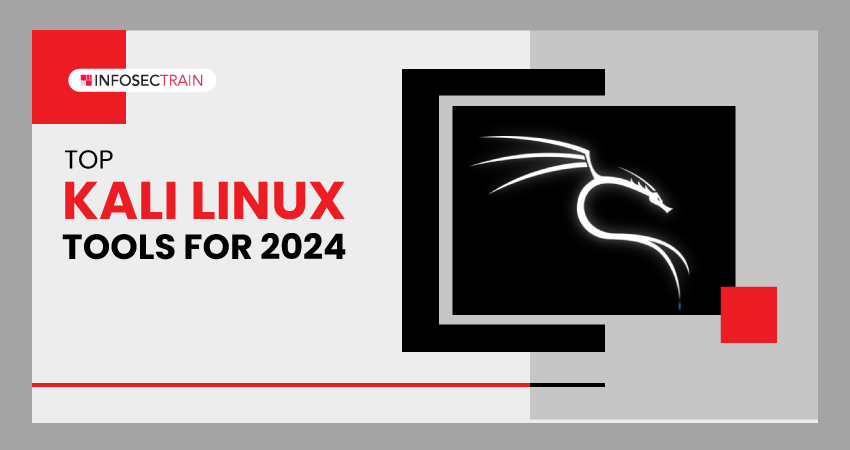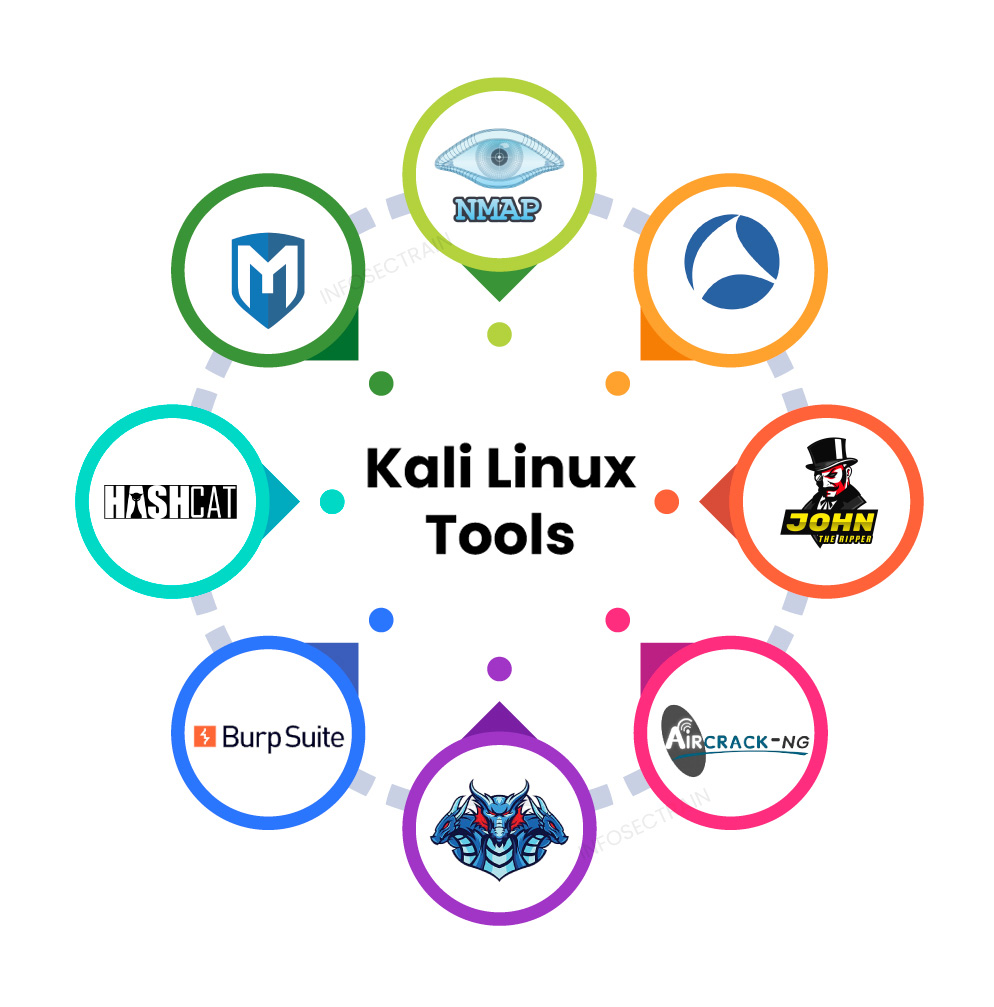Top Kali Linux Tools for 2024
In the realm of cybersecurity, Kali Linux stands as a powerhouse, offering an array of cutting-edge tools designed to secure digital assets and unveil vulnerabilities. In this article, we explore the “Top Kali Linux Tools,” providing insights into the latest and most potent resources within Kali’s arsenal for robust cybersecurity and ethical hacking efforts.

What is Kali Linux?
Kali Linux is a Debian-based Linux distribution that is designed for advanced penetration testing and security auditing. It is an extensively used open-source operating system among cybersecurity professionals, ethical hackers, and penetration testers for performing various security-related tasks such as network and system penetration testing, vulnerability assessment, digital forensics, and reverse engineering. Kali Linux has many pre-installed security tools, including information gathering, vulnerability analysis, password attacks, wireless attacks, web application analysis, and exploitation tools. Offensive Security, a leading cybersecurity training and penetration testing service provider, developed the Kali Linux project.
Kali Linux Tools for 2024
Kali Linux is a popular open-source distribution widely used by cybersecurity professionals, hackers, and penetration testers for various security-related tasks. It comes pre-loaded with a plethora of powerful tools for network analysis, vulnerability assessment, web application testing, and more. Here are some of the top Kali Linux tools:
 1. Metasploit: Metasploit is a popular open-source framework used for penetration testing, network security assessments, and ethical hacking. It was initially created in 2003 by H. D. Moore as a portable network tool using Perl scripting language. It has since evolved into a powerful, flexible framework for vulnerability scanning, exploit development and payload creation.
1. Metasploit: Metasploit is a popular open-source framework used for penetration testing, network security assessments, and ethical hacking. It was initially created in 2003 by H. D. Moore as a portable network tool using Perl scripting language. It has since evolved into a powerful, flexible framework for vulnerability scanning, exploit development and payload creation.
Features
- Exploit Development: Metasploit allows for creating custom exploits for specific vulnerabilities, which can be used to test and exploit systems and networks.
- Payload Creation: Metasploit includes various payload options, including shellcode, Meterpreter, and various stages, which can be used to gain access and control over a target system.
- Post-Exploitation: Once a system is compromised, Metasploit provides a range of post-exploitation modules that allow users to maintain access and gather information about the target.
- Automated Exploitation: Metasploit provides automation capabilities for tasks like vulnerability scanning and exploit generation, which can save time and effort during the testing process.
- Integration: Metasploit integrates with various other security tools, including Nmap, Nessus, and OpenVAS, to provide a comprehensive testing and assessment solution.
2. Nmap: Nmap (Network Mapper) is a popular open-source network exploration and security auditing tool. It is designed to scan and map networks, identify hosts, and discover services and vulnerabilities in those hosts.
Features
- Host discovery: Nmap can identify hosts that are up or down on a network.
- Port scanning: Nmap can identify open ports and services on a target host.
- Operating system identification: Nmap can determine the operating system of a target host.
- Version detection: Nmap can determine the versions of software running on a target host.
- Scriptable interaction: Nmap can be scripted to interact with a target system and perform advanced tasks.
- Output options: Nmap can output results in various formats, including XML, HTML, and plain text.
- Ping sweep: Nmap can quickly scan many hosts to determine which ones are up or down.
- Stealth scanning: Nmap may employ various tactics to avoid being detected by firewalls and intrusion detection systems.
- Vulnerability scanning: Nmap can be utilized to recognize potential system vulnerabilities.
3. Wireshark: Wireshark is a popular open-source network protocol analyzer used for network troubleshooting, analysis, development, and security auditing. It allows users to capture and view the traffic flowing over a network, decode and analyze packets, and diagnose and solve network problems.
Features
- Packet capture: Wireshark can capture network traffic from various sources, including Ethernet, WiFi, Bluetooth, and USB devices.
- Protocol analysis: Wireshark supports hundreds of protocols and can decode and analyze packets to provide detailed information about the traffic flowing over a network.
- Graphical user interface: Wireshark provides a user-friendly interface that allows users to visualize and analyze packet captures and includes a wide range of customizable displays and options.
- Filtering and search: Wireshark offers powerful filtering and search capabilities, allowing users to isolate and analyze specific traffic based on various criteria.
- Protocol analysis plugins: Wireshark supports using plugins to extend its capabilities and add support for additional protocols.
- VoIP analysis: Wireshark includes features for analyzing Voice over IP (VoIP) traffic, including support for SIP, H.323, and RTP protocols.
- Network troubleshooting: Wireshark can be used to diagnose and solve a wide range of network problems, including issues with network performance, connectivity, and security.
- Multi-platform support: Wireshark is available for various platforms, including Windows, Linux, and macOS.
4. John the Ripper: John the Ripper is a popular open-source password-cracking tool. It is designed to test the strength of passwords by attempting to crack them using various methods, including dictionary attacks, brute-force attacks, and rainbow table attacks.
Features
- Password cracking: John the Ripper is primarily used for password cracking, supporting various hash types and attack methods.
- Multi-platform support: John the Ripper is available for various platforms, including Windows, Linux, and macOS.
- Customization: John the Ripper can be customized with various options and configurations to optimize its performance for specific cracking scenarios.
- Plugin support: John the Ripper supports using plugins to extend its functionality and add support for additional hash types and attack methods.
- Performance optimization: John the Ripper includes various performance optimization features, such as multi-threading and GPU acceleration, to improve cracking speed.
- Command-line interface: John the Ripper is primarily used through a command-line interface, allowing users to automate and script their cracking tasks.
5. Aircrack-ng: Aircrack-ng is a popular open-source tool used for network security testing, particularly in the area of wireless networks. It provides a set of tools for auditing and cracking wireless network passwords and monitoring wireless network traffic.
Features
- Packet capture: Aircrack-ng can capture wireless network traffic and decode packets in real-time.
- Password cracking: Aircrack-ng provides tools for testing the security of wireless networks by cracking passwords using various techniques, including dictionary attacks, brute-force attacks, and WPA/WPA2 handshake cracking.
- Network monitoring: Aircrack-ng can be used to monitor wireless network traffic and identify vulnerabilities in the network.
- Multi-platform support: Aircrack-ng is available for various platforms, including Windows, Linux, and macOS.
- Customizable parameters: Aircrack-ng offers a range of customizable parameters to optimize the performance of the tools and adapt to different network environments.
- WEP and WPA/WPA2 support: Aircrack-ng supports cracking passwords for both WEP and WPA/WPA2 wireless networks.
- Scripting support: Aircrack-ng supports scripting and automation of various tasks through its command-line interface.
6. Hydra: Hydra is a popular open-source password-cracking tool used for testing the strength of passwords by attempting to crack them using various methods, including dictionary attacks, brute-force attacks, and rainbow table attacks. It is designed to work with various network services and protocols, including FTP, SSH, Telnet, HTTP, and many others.
Features
- Password cracking: Hydra is primarily used for password cracking, supporting many protocols and attack methods.
- Multi-protocol support: Hydra supports many network protocols, including FTP, SSH, Telnet, HTTP, and many others.
- Customizable options: Hydra offers a range of customizable options, allowing users to optimize the tool for specific cracking scenarios.
- Multi-threaded performance: Hydra is designed to use multi-threading and parallel processing, enabling faster cracking times.
- Brute-force and dictionary attacks: Hydra supports both brute-force and dictionary attacks, allowing users to choose the best approach for their specific cracking scenario.
- Scripting support: Hydra supports scripting and automation of various tasks through its command-line interface.
- Modularity: Hydra is modular in design, allowing users to add support for new protocols and attack methods easily.
7. Burp Suite: Burp Suite is a popular integrated platform used for web application security testing. It provides a range of tools for identifying and exploiting vulnerabilities in web applications and analyzing and manipulating web application traffic.
Features
- Web application scanning: Burp Suite provides a web application scanner that can automatically identify common vulnerabilities in web applications, such as SQL injection, cross-site scripting (XSS), and insecure server configurations.
- Proxy server: Burp Suite includes a proxy server that intercepts and modifies web application traffic, allowing users to analyze and manipulate requests and responses.
- Application vulnerability testing: Burp Suite provides various tools for manual testing of web application vulnerabilities, including SQL injection, XSS, and CSRF.
- Session handling: Burp Suite includes tools for managing and manipulating session cookies, allowing users to test for session-related vulnerabilities easily.
- Automated testing: Burp Suite can be used to automate repetitive testing tasks, such as testing for common vulnerabilities on multiple pages or applications.
- Collaborative testing: Burp Suite supports collaborative testing, allowing multiple users to work together on testing web applications.
- Customizable workflows: Burp Suite provides a range of customizable workflows and extensions, allowing users to customize the tool to their specific testing needs.
8. Hashcat: Hashcat is a popular open-source password-cracking tool used for testing the strength of passwords by attempting to crack them using various methods, including dictionary attacks, brute-force attacks, and mask attacks. It supports many hash types, including MD5, SHA-1, SHA-256, SHA-512, and many others.
Features
- Password cracking: Hashcat is primarily used for password cracking, supporting many hash types and attack methods.
- Multi-processor support: Hashcat is designed to use multi-processor systems, enabling faster cracking times.
- Multi-hash support: Hashcat supports cracking multiple hashes simultaneously, which can help to speed up the cracking process.
- Customizable options: Hashcat offers a range of customizable options, allowing users to optimize the tool for specific cracking scenarios.
- Brute-force, dictionary, and mask attacks: Hashcat supports a range of attack methods, including brute-force, dictionary, and mask attacks, allowing users to choose the best approach for their specific cracking scenario.
- Distributed computing: Hashcat supports distributed computing, allowing users to distribute cracking tasks across multiple systems to speed up the cracking process.
- GPU acceleration: Hashcat supports GPU acceleration, allowing users to use graphics cards’ processing power to speed up the cracking process.
Final Thoughts
Kali Linux is a popular Linux distribution used by security professionals and Penetration Testers for conducting security testing, vulnerability assessments, and penetration testing. It includes many tools for testing network security, web application security, wireless security, password cracking, and more. If you are interested in learning more about Kali Linux, check out InfosecTrains’s Network Penetration Testing and Web Application Penetration Testing training course for your learning.




 1800-843-7890 (India)
1800-843-7890 (India) 
